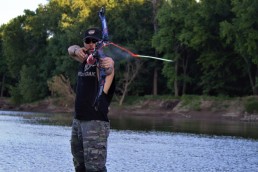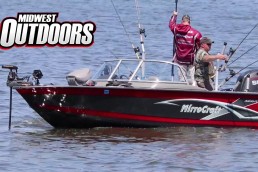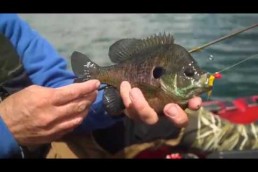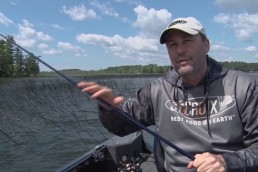Kinetic Bow fishing
SHARE THIS POST
A 3-foot-long shadow slid upstream into slack water on the seam of current from the main river channel. At full draw, I sent an arrow at the dark spot, punching through the water’s surface. The fiberglass shaft shuttered, indicating a hit, though the grass carp that created the shadow flashed violently, rolled, and then thrashed away unscathed.
I had hit my mark, but had lost the fish because the arrow deflected.
Successful bowfishing can be boiled down to the focused transfer of kinetic energy. Here are five ways to maximize the amount of energy you put on your quarry that can result in you landing more fish.
Stealth mode
The best way to ensure you’re hitting fish with the most kinetic energy is to get as close as possible before taking a shot. Different species have varying levels of tolerance for the disturbance a trolling motor causes. Get the drop on the fish by using your trolling motor strategically, and sparingly. Establish the trajectory you want with the boat, build up the momentum you need, and then quietly coast into high-potential water with the trolling motor off. Getting closer for shots not only means there’s more kinetic energy at the point of impact, but it also makes your targets bigger. Don’t be surprised if you start seeing more fish too.
Go long
Bowhunters know how important it is to set bows to the right draw length. Much of that importance is driven by seeing the peep and pins the same every single time—two aspects of archery not necessary in bowfishing. Leaving an extra inch or more of extra draw length on your bowfishing rig will allow for additional energy on a shot. That extra energy comes in handy when you’re taking a longer shot or shooting a fish capable of deflecting most arrow tips, like a big gar.
It may feel a little odd coming past your typical anchor point (the corner of your mouth), but after you long-bomb or solidly stick a few thick-scaled giants, you’ll get accustomed to occasionally stretching out your draw. Just be sure your arrow is long enough to accommodate the stretch too.
Up close and personal
Speaking of getting close, in my experience, how close a fish allows you to approach can change from day to day. While I haven’t figured out all of the variables involved, I usually spend the first few encounters experimenting with proximity. In general, I find gar tend to be the least concerned about the boat, while silver and grass carp need very little reason to dismiss themselves from your presence. There are no extra points for long shots, so play a little game of “chicken” with the fish early on to see what they’re in the mood for.
A.B.F. (Always Be Fishing)
How many times have you fished the surfaced while you’re backing out an arrow that completely passed through one you just shot? Time off the deck can mean missed opportunities. Minimize your downtime by making it simple to detach your arrow from your line.
Start by cutting an 8-inch piece of line and running it through your safety slide. Hold both ends together and tie an overhand knot, creating a loop. Next, at the running end of your bowfishing line, tie another loop by doubling over the line and tying another overhand knot to create another loop. Push the safety slide to the front of the arrow and pass the loop at the running end of the line through the loop hanging down from the safety slide. Then slide the running-end loop over the point of your arrow and slide the entire assembly to the safety stop but continue pulling the running-end loop over the nock. Cinch your connection down, and you’ve just created a girth-hitch connection to your arrow. When you need to untangle a mess or shoot all the way through a fish, it’s now easy to remove the arrow and reattach. You’ll be ready to fish again while your buddies are still cursing their tangles.
The point of it all
Are you enjoying this post?
You can be among the first to get the latest info on where to go, what to use and how to use it!
Marksmanship, kinetic energy and even shot placement mean little if you’re shooting with a dull point. A flattened tip is more likely to distribute its energy via a shocking impact that deflects. A sharp tip penetrates, allowing the arrow to maintain its energy so it can be carried deeper or even through the fish. Arrows that strike rocks, hard gravel bottoms, trees or even fish skulls can lose their point enough to cost you a fish.
In between trips, touch up your points with a grinding attachment on a tool like a Dremel. A fine wheel on a bench grinder can do the trick too, but take extra care not to soften the metal by overheating it. In your on-the-water kit, be sure to bring a sharpening stone or a fine file for a field-expedient solution. Keeping some extra tips and arrows on hand is a good idea too.
Remember, as ambassadors of a rapidly growing and developing pursuit, we must take care to bowfish responsibly. We have a responsibility to dispose of our fish courteously. Too often, I’ve been given a talking to at the boat ramp by individuals who assume I’m going to dump fish there. They’ve seen others do it, and their perspective has become that all bowfishermen are inconsiderate. Let’s change that perception.
Successfully boating good numbers of fish while bowfishing is no accident. It requires the effective management of the kinetic energy in your shot. Use these tactics to put more punch in your arrow and you may need a bigger “container” to hold all your fish. MWO
The first step to simplifying getting fish off the line when the arrow passes through them: a loop of bowfishing line tied onto the safety slide.
Tim Kjellesvik (left) and Tony Cantrell (right) hold up examples of the size of fish you can kill when you pay attention to kinetic energy. Photo: Josiah Durham
The loop on the running end of the bowfishing line is girth-hitched onto the loop on the safety slide to create a secure and removable link from line to arrow.
Keep the kinetic energy in your arrow by maintaining a sharp point.
The energy remaining in your arrow when it strikes a fish will determine if the point penetrates or deflects. Photo: Josiah Durham
Drawing beyond your typical anchor point may not feel natural, but it makes for a more forceful shot.
Photo: Josiah Durham
Closer shots allow the arrow to deliver more punch to the fish as opposed to spending it on a long flight.
Photo: Josiah Durham
MWO
SHARE THIS POST
Did you enjoy this post?
You can be among the first to get the latest info on where to go, what to use and how to use it!
Tim Kjellesvik
MidWest Outdoors works with more than 200 outdoor experts each year, who contribute articles based on their areas of expertise. MidWest Outdoors magazine offers more fishing and hunting articles than any other publication!



